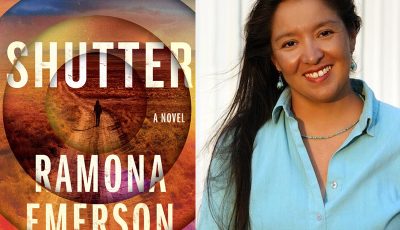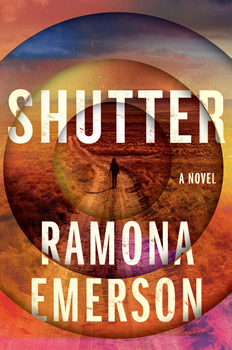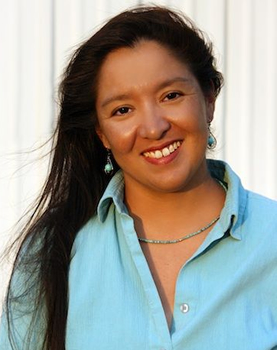

BookTrib Spotlight: Ramona Emerson
Crime, Character, the Supernatural—a Navajo Takes Back Her Story
Souls don’t scatter like the rest of the body. They latch on for as long as they can, their legs pulled to the sky, fingertips white in desperation. Souls are grasping for us, for the ones they left behind, and for the truth only they can see. They are the best witnesses to their last breath.
In Ramona Emerson’s SHUTTER, Rita Todacheene knows that all too well. A forensic photographer for the Albuquerque, New Mexico, police department, she is an expert on capturing a crime scene, finding the small details that analysts sometimes missed. But she has other help as well. As a baby on the Navajo reservation, she never slept, and her grandmother would assure people, “There is nothing wrong with her. She’s just talking to someone out there, and it’s none of our business.”
Eventually, though, it becomes everybody’s business. Rita sees the ghosts of the departed, and they tell her things, sometimes insisting on justice or at least some answers. “If you keep inviting dead things into your life, it could open the door,” warns a medicine man brought in by Rita’s grandmother. “Don’t let them know there is a door. Don’t let them know that you are the key.”
It is advice she follows carefully until the day she’s called to the scene of a suicide, a woman who jumped off a bridge over a highway, her body torn apart by the traffic below. Furiously, the woman’s ghost insists that she was murdered, her body tossed off the bridge, and refuses to let Rita rest, pushing harder and harder in a single-minded quest for revenge.
As Rita investigates, her life starts to fall apart, driving her deeper and deeper into a different shadow world, one of drug dealers, cartel lieutenants, and crooked cops, the ghosts pulling her in one direction, the all-too-living criminals pulling in another.
But she has no choice. The door is open now. She either has to see this through—or become a dead thing herself.
SHUTTER is an extraordinary debut, a stunning mix of crime, character study, and the supernatural, told in propulsive prose against the landscape of the Navajo Nation. It’ll leave you gasping—and desperate to read what the author does next.
Ramona Emerson already has a remarkable resume. A Dine writer and filmmaker, she has a bachelor’s in media arts from the University of New Mexico and an MFA in creative writing from the Institute of American Indian Arts. After working in forensic videography herself, she began a new career as a documentary filmmaker, telling complex and personal stories about Navajo life that question and redefine the expectations of Native cultural identity. She is an Emmy nominee, a Sundance Native Lab Fellow, a Time-Warner Storyteller Fellow, a Tribeca All-Access Grantee, and a WGBH Producer Fellow, and for the past two decades, she has run her own production company, Reel Indian Pictures, with her husband. In 2020, she was appointed to the Governor’s Council on Film and Media Industries for New Mexico.
“I was drawn to make films about my community because those stories weren’t being told,” she says. “More importantly, if they were being told, they were being told by people outside of our communities. There are a million films waiting to be made about the extraordinary people who live on the reservation. I don’t have enough time to tell them all, but I work hard to educate people about who we really are. I don’t embrace any notions of poverty porn or the victimization of our people for profit. I tell empowering and positive stories about the people fighting to exist in a country that would rather forget them.
“When I graduated from UNM after studying film, there really were no jobs or opportunities in the film industry. I called almost every film and video firm until one of them finally invited me to apply [as a forensic photographer]. He was the only one who would hire me and give me access to equipment. I just had to get certified and learn the procedures… which I did for the next 16 years. I did all the video work and some of the photography—I learned a lot about clarity and precision, and I think it helped me as a filmmaker both aesthetically and emotionally because I learned to tell other peoples’ stories and understood the responsibility that comes with that.”
As to why she made this story as a novel rather than a film, “I think it started with a documentary project I wanted to do about Navajo people who had jobs dealing with death—as a Navajo, it is a strange dichotomy. At the time, I was winding down my job as the video production manager at a private forensic firm and attending a writers’ workshop in northern New Mexico. So it all started to bleed into each other, and I started writing short pieces about my grandma and these other slightly creepy short tales. Then I started my MFA program, and it exploded.
“When I was getting ready to apply for my MFA program at IAIA, I asked my writing workshop instructor, Joan Tewkesbury, for a letter of recommendation. She asked me what I was going to study, and when I told her I was doing the screenwriting track, she responded quickly. She let me know that she would only write a letter if I went into fiction. I never thought that I could write fiction—much less a novel. But Joan believed in me and wanted me to keep writing what I had started in workshop. Fiction gives you the freedom to think big—to imagine and create worlds. When I write screenplays, all I can think about is the budget—or lack thereof.”
The novel also let Emerson tap into her whole life—her past, her family, her people.
“My grandmother was a huge part of my life and meant everything to me,” she says. “She was the strongest person I have ever known. She took care of all of us alone with so little. I wish she was here to see the book. She was the one who taught me to read and told me I was a good writer. She never got to see my films either. I guess she’s here in a way… always will be.
“My mother is an artist—a painter mostly but also a photographer. As a child, I grew up waiting for her in the darkroom while she attended art school. So I have very tangible memories of creating images with light, even without a camera. My mother and stepdad also taught me about pin hole cameras and even dabbled in filmmaking. But it goes back even further to my Grandpa Nelson, who loved to take pictures of his adventures overseas while he was boxing in the army. He died way before I was born, but that connection runs deep.
“Rita’s first case was like one of the first cases I worked on—where I was slyly hustled in to get photos they didn’t want me to see. I also worked in a few random details from other cases.
“When I was writing SHUTTER, I went to an Albuquerque Police Department civilian forensic class for 16 weeks and learned all about crime scene procedures—everything from fingerprints, ballistics, blood spatter, etc. We learned from real APD cases and were tested on staged crime scenes. I pulled a lot of what I learned there into the book, so much of it is based on real cases here in Albuquerque.
“I am a big researcher, and I wouldn’t write about something I didn’t have a full capacity of understanding. So I read a lot, go to the specific places I talk about, take classes/workshops to get into a character, write copious notes, and then I start to visually see the story unfold in my head and write it. I also create long, curated playlists that go with whatever scene I’m writing. I have a very small workspace in our house, in the corner of the living room, so I have to wear headphones and get to work. I’m constantly juggling everything: parenting, working on video and film projects… so I have to carve out time to write.”
The connection to her people brings out especially strong opinions when it comes to both her filmmaking and her fiction.
“The Sundance Lab nearly broke my spirit, because I realized that it was a quota—not really a career-changing opportunity,” she says. “I think so many diversity programs have the same issues… all the dreams and none of the follow-through. People like to talk about diversity, but when it comes down to it, they aren’t going to hire you unless you can make them money.
“Out of all of those experiences I’ve had working with organizations who support BiPOC in the film industry, it was the WGBH Producers Academy that really introduced me to a community of filmmakers who want to make films and help each other in the process. It was never about ego. We all still stay in touch and hire each other when we have the opportunity. That is real change.”
Regarding the book: “There are no Navajo women writing this kind of fiction, period. I grew up reading Stephen King because that is what I had access to, but I always wished I could hear about anything from a Navajo perspective. There were early Navajo anthropological films and media created by missionaries and of course bad Westerns. For me, it was all bad news. But the biggest slap in the face continues to be the fact that people get Navajo stories from a white man. Tony Hillerman was the go-to person for Navajo literature for years, and it angered me to no end. SHUTTER came from that rage. I wanted to take our stories back from him.
“Almost all of it comes from my own memories or from stories that I heard growing up,” Emerson says. “There is not one thing about the Navajo perspective that is altered from my own experiences and upbringing in that space.”
Even with all that motivation, though, it was still a long process from those first short stories to the finished book.
“I wrote the first draft of SHUTTER while I was in my MFA program,” she says. “For those two years, I turned about 10 short stories into pieces of chapters and started fleshing it out. It turned into 300 pages and a degree. After graduation, one of my mentors shared my story with her agent, and she signed me on pretty quickly. I then started rewriting the first draft when I was at Pam Houston’s Writing by Writers fellowship workshops and pulled a new version from that week of work. It was there that a fellow writer passed some writing onto Soho, and Juliet—my editor—called me for the first time, very interested in what I had sent her. My agent at the time didn’t want me to go with a smaller press, so it took about four years of rewrites and 28 rejections before I was dumped by my agent. That is when I called Juliet back, and she pulled me from the wreckage of obscurity.
“The entire book, from segments at workshop to full publication, took about 10 years.”
What’s next? What is she working on? As it turns out, plenty.
“I’m working on the second book from the SHUTTER trilogy,” she says. “I’ve been researching lots of serial killers and Catholic stuff… so I’ll leave that there. I am also in production on four separate documentaries and doc-series. I’m doing editing on my husband’s documentary about three generations of Taos Pueblo potters. We are also working on a documentary about Chicano activist and photographer Maria Varela, who worked with SNCC in the sixties and helped to create voting education for sharecroppers in Mississippi as well as work to get Blacks registered to vote in the South. We are also working on a four-part docuseries about border-town violence against Navajo/Native people in four communities surrounding Native lands.
“Never a dull moment here at Reel Indian Pictures!”
*****
Neil Nyren retired at the end of 2017 as the executive VP, associate publisher, and editor in chief of G. P. Putnam’s Sons. He is the winner of the 2017 Ellery Queen Award from the Mystery Writers of America. Among his authors of crime and suspense were Clive Cussler, Ken Follett, C. J. Box, John Sandford, Robert Crais, Jack Higgins, W. E. B. Griffin, Frederick Forsyth, Randy Wayne White, Alex Berenson, Ace Atkins, and Carol O’Connell. He also worked with such writers as Tom Clancy, Patricia Cornwell, Daniel Silva, Martha Grimes, Ed McBain, Carl Hiaasen, and Jonathan Kellerman.
He is currently writing a monthly publishing column for the MWA newsletter The Third Degree, as well as a regular ITW-sponsored series on debut thriller authors for BookTrib.com and is an editor at large for CrimeReads.
This column originally ran on Booktrib, where writers and readers meet.
- The Ballad of the Great Value Boys by Ken Harris - February 15, 2025
- Don’t Look Down by Matthew Becker - February 15, 2025
- The Wolf Tree by Laura McCluskey - February 14, 2025



